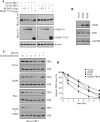Ubiquitin Ligase RLIM Modulates Telomere Length Homeostasis through a Proteolysis of TRF1
- PMID: 19164295
- PMCID: PMC2659214
- DOI: 10.1074/jbc.M806702200
Ubiquitin Ligase RLIM Modulates Telomere Length Homeostasis through a Proteolysis of TRF1
Abstract
The telomeric protein TRF1 negatively regulates telomere length by inhibiting telomerase access at the telomere termini, suggesting that the protein level of TRF1 at telomeres is tightly regulated. Regulation of TRF1 protein abundance is essential for proper telomere function and occurs primarily through post-translational modifications of TRF1. Here we describe RLIM, a RING H2 zinc finger protein with intrinsic ubiquitin ligase activity, as a TRF1-interacting protein. RLIM increases TRF1 turnover by targeting it for degradation by the proteasome in a ubiquitin-dependent manner, independently of Fbx4, which is known to interact with and negatively regulate TRF1. Whereas overexpression of RLIM decreases the level of TRF1 protein, depletion of endogenous RLIM expression by small hairpin RNA increases the level of TRF1 and leads to telomere shortening, thereby impairing cell growth. These results demonstrate that RLIM is involved in the negative regulation of TRF1 function through physical interaction and ubiquitin-mediated proteolysis. Hence, RLIM represents a new pathway for telomere maintenance by modulating the level of TRF1 at telomeres.
Figures







Similar articles
-
The F-box protein FBX4 targets PIN2/TRF1 for ubiquitin-mediated degradation and regulates telomere maintenance.J Biol Chem. 2006 Jan 13;281(2):759-68. doi: 10.1074/jbc.M509855200. Epub 2005 Nov 7. J Biol Chem. 2006. PMID: 16275645
-
NEDD8 ultimate buster-1 regulates the abundance of TRF1 at telomeres by promoting its proteasomal degradation.FEBS Lett. 2016 Jun;590(12):1776-90. doi: 10.1002/1873-3468.12221. Epub 2016 Jun 4. FEBS Lett. 2016. PMID: 27214791
-
The F-box protein β-TrCP promotes ubiquitination of TRF1 and regulates the ALT-associated PML bodies formation in U2OS cells.Biochem Biophys Res Commun. 2013 May 17;434(4):728-34. doi: 10.1016/j.bbrc.2013.03.096. Epub 2013 Apr 10. Biochem Biophys Res Commun. 2013. PMID: 23583392
-
Post-translational modifications of TRF1 and TRF2 and their roles in telomere maintenance.Mech Ageing Dev. 2012 Jun;133(6):421-34. doi: 10.1016/j.mad.2012.05.002. Epub 2012 May 23. Mech Ageing Dev. 2012. PMID: 22634377 Review.
-
Role of Pin2/TRF1 in telomere maintenance and cell cycle control.J Cell Biochem. 2003 May 1;89(1):19-37. doi: 10.1002/jcb.10496. J Cell Biochem. 2003. PMID: 12682905 Review.
Cited by
-
Tankyrase-targeted therapeutics: expanding opportunities in the PARP family.Nat Rev Drug Discov. 2012 Dec;11(12):923-36. doi: 10.1038/nrd3868. Nat Rev Drug Discov. 2012. PMID: 23197039 Review.
-
Activity-based probe profiling of RNF12 E3 ubiquitin ligase function in Tonne-Kalscheuer syndrome.Life Sci Alliance. 2022 Jun 28;5(11):e202101248. doi: 10.26508/lsa.202101248. Print 2022 Nov. Life Sci Alliance. 2022. PMID: 35764390 Free PMC article.
-
Telomeric armor: the layers of end protection.J Cell Sci. 2009 Nov 15;122(Pt 22):4013-25. doi: 10.1242/jcs.050567. J Cell Sci. 2009. PMID: 19910493 Free PMC article.
-
ADP-ribosyltransferases and poly ADP-ribosylation.Curr Protein Pept Sci. 2015;16(6):491-501. doi: 10.2174/1389203716666150504122435. Curr Protein Pept Sci. 2015. PMID: 25938242 Free PMC article. Review.
-
Extending the clinical spectrum of X-linked Tonne-Kalscheuer syndrome (TOKAS): new insights from the fetal perspective.J Med Genet. 2024 Aug 29;61(9):824-832. doi: 10.1136/jmg-2024-109854. J Med Genet. 2024. PMID: 38849204 Free PMC article.
References
-
- Smogorzewska, A., and de Lange, T. (2004) Annu. Rev. Biochem. 73 177-208 - PubMed
-
- Blasco, M. A., Lee, H. W., Hande, M. P., Samper, E., Lansdorp, P. M., DePinho, R. A., and Greider, C. W. (1997) Cell 91 25-34 - PubMed
-
- Harrington, L. (2005) Chromosome Res. 13 493-504 - PubMed
-
- Lingner, J., Cooper, J. P., and Cech, T. R. (1995) Science 269 1533-1534 - PubMed
-
- Cerone, M. A., Autexier, C., Londoño-Vallejo, J. A., and Bacchetti, S. (2005) Oncogene 24 7893-7901 - PubMed
Publication types
MeSH terms
Substances
LinkOut - more resources
Full Text Sources
Molecular Biology Databases

